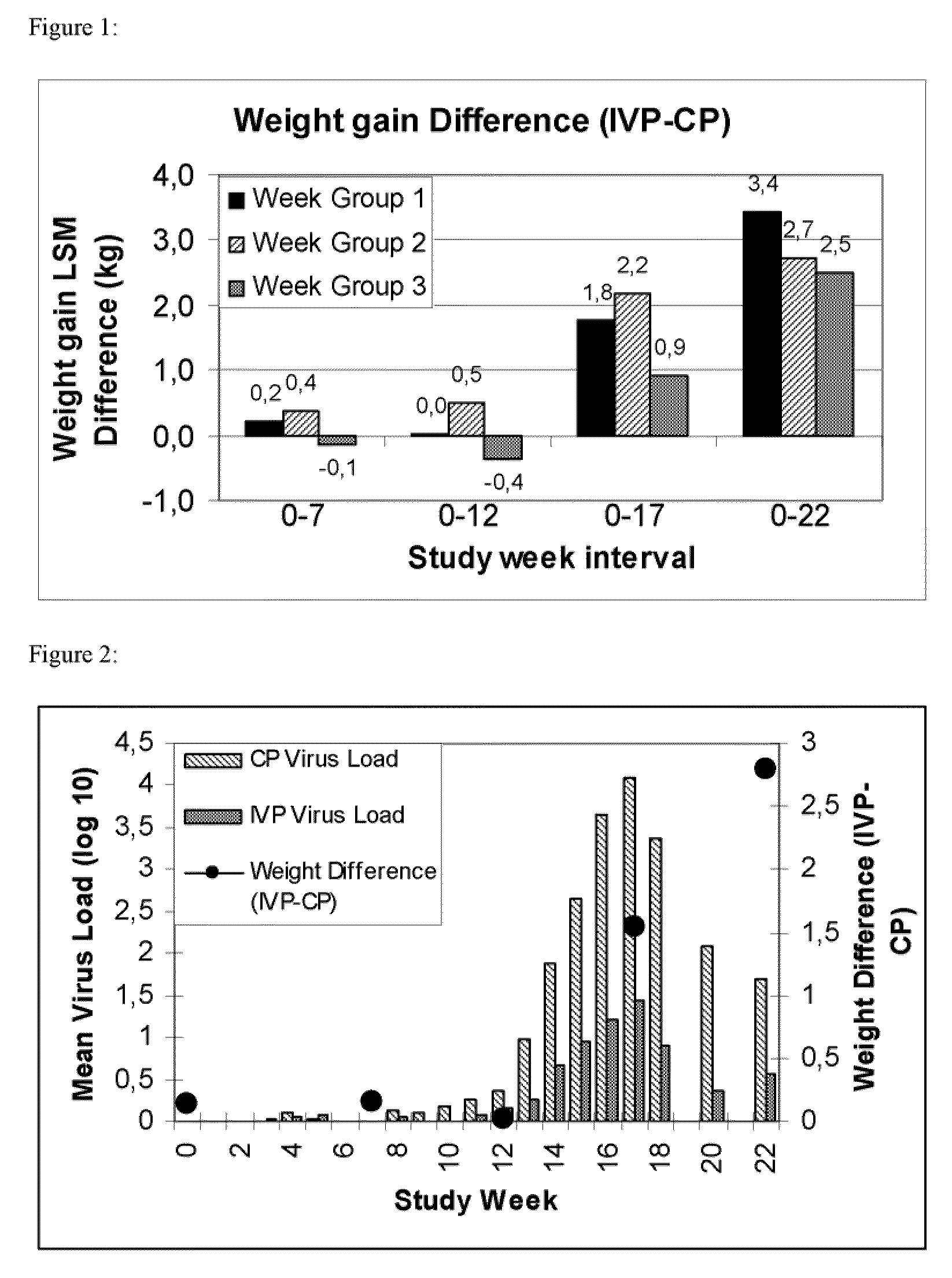Treatment of PRDC in pigs
a technology for prdc and pigs, applied in the field of treatment of prdc in pigs, can solve the problems of slow growth, decreased feed efficiency, lethargy, anorexia, etc., and achieve the effects of reducing clinical symptoms, reducing viral load, and reducing the overall circovirus load
- Summary
- Abstract
- Description
- Claims
- Application Information
AI Technical Summary
Benefits of technology
Problems solved by technology
Method used
Image
Examples
example 1
Preparation of PCV2 ORF-2 Antigen
[0086]Initial SF+ cell cultures from liquid nitrogen storage were grown in Excell 420 media (JRH Biosciences, Inc., Lenexa, Kans.) in suspension in sterile spinner flasks with constant agitation. The cultures were grown in 100 mL to 250 mL spinner flasks with 25 to 150 mL of Excell 420 serum-free media. When, the cells had multiplied to a cell density of 1.0-8.0×106 cells / mL, they were split to new vessels with a planting density of 0.5-1.5×106 cells / mL. Subsequent expansion cultures were grown in spinner flasks up to 36 liters in size or in stainless steel bioreactors of up to 300 liters for a period of 2-7 days at 25-29° C.
[0087]After seeding, the flasks were incubated at 27° C. for four hours. Subsequently, each flask was seeded with a recombinant baculovirus containing the PCV2 ORF-2 gene (SEQ ID NO: 4). The recombinant baculovirus containing the PCV2 ORF-2 gene was generated as described in WO06 / 072065. After being seeded with the baculovirus, t...
example 2
Anti PCV-2 Immuno Assay
[0089]PK15 (e.g. ATCC CCL-33) or VIDO R1 cells described in WO 02 / 07721, are seeded onto a 96 well plate (about 20,000 to 60,000 cells per wells). Cells are infected with a PCV2 isolate, when monolayers are approximately 65 to 85% confluent. Infected cells are incubated for 48 hours. Medium is removed and wells are washed 2 times with PBS. The wash buffer is discarded and cells are treated with cold 50 / 50 methanol / acetone fixative (˜100 μl / well) for about 15 min at about −20° C. The fixative is discarded and the plates are air dried. Serial dilutions of porcine serum samples are prepared in PBS, added to the plates and incubated to allow antibodies to bind if present in the serum samples for about 1 hr at 36.5±1° C. In addition, serial dilutions of an anti-PCV2 positive and negative control sample (Positive Control and Negative Control Samples) are run in parallel. The plates are then washed three times with PBS. The PBS is discarded. Plates are then stained w...
example 3
Efficacy of PCV2 ORF-2 (Ingelvac® CircoFLEX™) in Treatment of PRDC
Objective
[0090]The purpose of this study was the demonstration of the efficacy of Ingelvac® CircoFLEX in the control of PCV2-associated PRDC.
Study Performance
[0091]1542 conventional pigs belonging to three consecutive week groups, each comprising approximately 500 animals, were included into the study. The study animals were blocked by weight and litter assignment and randomly assigned to one group of vaccinates (n=769) and one control group (n=773).[0092]Group 1: At study day 0 the pigs were vaccinated intramusculary at the age of approximately 20 days by a single dose of Ingelvac® CircoFLEX containing PCV2 ORF-2 protein as the active substance with an RP of 1 (per dose of 1 ml) and Carbopol® as adjuvant.[0093]Group 2: The control group received 1 ml of control article which contained PCV2 ORF-2 protein free cell culture supernatant and Carbopol® as adjuvant.[0094]Group 3; Untreated pigs.
[0095]The study was terminate...
PUM
| Property | Measurement | Unit |
|---|---|---|
| diameter | aaaaa | aaaaa |
| size | aaaaa | aaaaa |
| shortening time | aaaaa | aaaaa |
Abstract
Description
Claims
Application Information
 Login to View More
Login to View More - R&D
- Intellectual Property
- Life Sciences
- Materials
- Tech Scout
- Unparalleled Data Quality
- Higher Quality Content
- 60% Fewer Hallucinations
Browse by: Latest US Patents, China's latest patents, Technical Efficacy Thesaurus, Application Domain, Technology Topic, Popular Technical Reports.
© 2025 PatSnap. All rights reserved.Legal|Privacy policy|Modern Slavery Act Transparency Statement|Sitemap|About US| Contact US: help@patsnap.com

